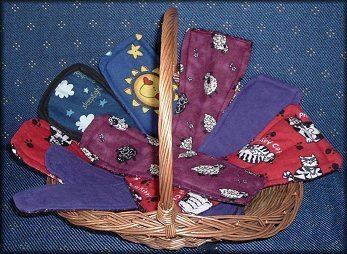 | ||
Cloth menstrual pads are cloth pads worn to absorb the menstrual flow during a woman's period. They are a type of reusable feminine hygiene product, and are an alternative to disposable sanitary napkins or to reusable menstrual cups. They are less expensive than disposable pads, reduce the amount of waste produced and may also have health benefits.
Contents
Generally they are made from layers of absorbent fabrics (such as cotton or hemp) which are worn by a woman while she is menstruating, for post-birth bleeding or any other situation where it is necessary to absorb the flow of blood from the vagina, or to protect underwear from regular discharge of vaginal fluids. After use, they are washed, dried and then reused.
Current use
The majority of commercially available pads are manufactured by work-at-home moms or small businesses and can be purchased through some health food stores, specialty stores, and via Internet stores and marketplaces. They are available in a range of lengths and thicknesses, similar to disposable pads, with longer pads for night use and thinner and shorter pads for light use. Some manufacturers will allow the buyer to select the fabrics, shape and size of the pad so that they can be custom made to fit an individual woman and be as efficient as possible.
Some women make their own cloth menstrual pads. These pads range from folded wash cloths to pads similar to the cloth menstrual pads available commercially.
Cloth menstrual pads may be hand or machine washed , and then dried on a clothes line or in a clothes dryer, depending on the instructions from the manufacturer. (Different fabrics require different care methods.) Some women choose to rinse out their pads in cold water before putting them in the wash with their other clothing. Others do not rinse, but put the soiled pads straight into the wash.
When changing cloth menstrual pads away from home, some women place the soiled pads into a waterproof or Ziploc bag to keep them from drying out and to contain or prevent odor and then wash the pads when convenient.
Stains sometimes occur. However, this is limited if the pads are rinsed out or soaked in cold water immediately after use. Some women prefer darker colored fabrics which do not show stains as much as light colored fabrics do. Causes of staining include allowing the blood to dry on the pad and using hot water when washing the pad. Drying cloth pads in sunlight can help to fade stains.
The fabrics used range from 100% natural fibres to 100% synthetics. Some commonly used fabrics include terrycloth, cotton, silk, hemp, and Gore-Tex. Specialty fabrics such as hemp, bamboo terry, bamboo velour, soy French terry, wool interlock and polyurethane laminate (PUL). PUL may be purchased from online nappy/diaper supply stores.
Some styles of cloth menstrual pad have a waterproof layer to help prevent the pad leaking through while other styles of cloth pad may rely on more layers of absorbency and not include waterproofing. Wool can also be used as a natural, breathable backing that provides leak protection.
Developing countries
In developing countries, reusable or makeshift pads are still used to collect menstrual blood. Women in these countries must often resort to either staying in their rooms during menstruation or using infection-causing items such as leaves, husks, disposed cement bags, etc. This issue affects millions of women without access to feminine hygiene products. This lack is directly tied to exploitation, drop out rates, infection, early marriage and even child trafficking. Quality washable menstrual pads are now helping as worldwide awareness is growing - also evidenced by the global initiative of "Menstrual hygiene day". Many NGOs are coordinating volunteers to sew effective washable pads with moisture barriers that, unlike disposables, can be used month after month.
In Somalia, where girls may be absent from school for a week each month due to menstruation, a charity has trained victims of gender based violence to sew re-usable sanitary pads, which are then purchased for distribution to schools in Mogadishu.
Positive aspects
Difficulties
History
Through the ages women have used different forms of menstrual protection. Women often used strips of folded old cloth (rags) to catch their menstrual blood, which is why the term "on the rag" was used to refer to menstruation.
Disposable menstrual pads appear to have been first commercially available from around 1888 with the Southall's pad. More widely successful disposable menstrual pads had their start during the first world war, when French nurses used Kimberly-Clark's wood pulp bandages as a menstrual pad that could be thrown away after use. Kotex's first advertisement for products made with this wood pulp appeared in 1921.
Until the advent of disposable pads, women used a variety of sewn or makeshift pads made from a variety of fabrics, often leftover scraps, to collect menstrual blood, although some women have used anything absorbent, to collect menstrual blood. Fabrics could generally be washed and used again. When disposable pads were introduced, they were too expensive for many women to afford. When they could be afforded, women were allowed to place money in a box so that they would not have to speak to the clerk and take a box of Kotex pads from the counter themselves. It took several years for disposable menstrual pads to become commonplace. However, they are now used nearly exclusively in most of the industrialized world.
Cloth menstrual pads made a comeback around 1970. With the number of cloth pad manufacturers and online communities devoted to this increasing in the 1990s and the early 2000s, they appear to be gaining popularity.
